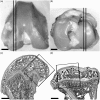Dietary 2-oxoglutarate mitigates gastrectomy-evoked structural changes in cartilage of female rats
- PMID: 26202375
- PMCID: PMC4935430
- DOI: 10.1177/1535370215595466
Dietary 2-oxoglutarate mitigates gastrectomy-evoked structural changes in cartilage of female rats
Abstract
Gastrectomy (Gx) leads to osteopenia/osteoporosis in humans and animals. However, little is known about the influence of Gx on the cartilage in this regard. Recent studies have demonstrated a protective effect of 2-oxoglutaric acid (2-Ox) on bone and cartilage. Hence, the purpose of this study was to investigate whether 2-Ox can mitigate eventual Gx-induced cartilage impairment. Twenty female Sprague-Dawley rats were subjected to Gx and randomly divided into two groups: Gx + 2-Ox and Gx. Another 20 rats were sham-operated (ShO) and randomly divided into two groups: ShO + 2-Ox and ShO. The daily dose of 2-Ox administered to the rats in the drinking water was 0.43 g per 100 g rat. After eight weeks, rats were euthanized and femora and tibiae were collected. Histology and histomorphometry analyses of the articular cartilage and the growth plate were done. Gx resulted in a 32% (±44.5 femur, ±35.8 tibia) decrease in overall thickness of articular cartilage in both bones (femur: ShO 279.1 ± 48.5 vs. Gx 190.2 ± 38.4 µm, tibia: ShO 222.9 ± 50.3 µm vs. Gx 151.3 ± 52.6 µm) (in some zones up to 58 ± 28.0%), and in the growth plate up to 20% (±22.4) (femur: ShO 243.0 ± 34.0 vs. Gx 207.0 ± 33.7 µm, tibia: ShO 220.0 ± 24.6 µm vs. Gx 171.1 ± 16.1 µm). Gx altered the spatial distribution of thick and thin collagen fibers, and chondrocyte shape and size. 2-Ox administration prevented the reduction in both cartilages thickness (Gx + 2-Ox: articular cartilage 265.2 ± 53.8 µm, 235.6 ± 42.7 µm, growth plate 236.7 ± 39.2 µm, 191.3 ± 16.5 µm in femur and tibia, respectively), and abolished the spatial changes in collagen distribution and structure induced by Gx. Gx affects cartilage structure and thickness, however, 2-Ox administration mitigates these effects and showed protective and stimulatory properties. Our observations suggest that dietary 2-Ox can be used to offset some of the changes in hyaline cartilage, in particular articular cartilage, following bariatric surgeries.
Keywords: 2-oxoglutaric acid; Histology; development; gastrectomy; histomorphometry; skeleton.
© 2016 by the Society for Experimental Biology and Medicine.
Figures




Similar articles
-
Dietary alpha-ketoglutarate reduces gastrectomy-evoked loss of calvaria and trabecular bone in female rats.Scand J Gastroenterol. 2008;43(5):551-8. doi: 10.1080/00365520701824951. Scand J Gastroenterol. 2008. PMID: 18415747
-
The effect of dietary administration of 2-oxoglutaric acid on the cartilage and bone of growing rats.Br J Nutr. 2013 Aug;110(4):651-8. doi: 10.1017/S0007114512005570. Epub 2013 Jan 11. Br J Nutr. 2013. PMID: 23308390
-
Effects of calcium deficiency and calcium supplementation on gastrectomy-induced osteopenia in the young male rat.Scand J Gastroenterol. 2002 Mar;37(3):299-306. doi: 10.1080/003655202317284200. Scand J Gastroenterol. 2002. PMID: 11916192
-
Can 2-oxoglutarate prevent changes in bone evoked by omeprazole?Nutrition. 2013 Mar;29(3):556-61. doi: 10.1016/j.nut.2012.07.014. Epub 2012 Dec 5. Nutrition. 2013. PMID: 23218481
-
Comparison of osteopenia after gastrectomy, ovariectomy and prednisolone treatment in the young female rat.Acta Orthop Scand. 2001 Oct;72(5):525-32. doi: 10.1080/000164701753532880. Acta Orthop Scand. 2001. PMID: 11728082
Cited by
-
The effect of maternal HMB supplementation on bone mechanical and geometrical properties, as well as histomorphometry and immunolocalization of VEGF, TIMP2, MMP13, BMP2 in the bone and cartilage tissue of the humerus of their newborn piglets.PLoS One. 2021 Feb 24;16(2):e0240642. doi: 10.1371/journal.pone.0240642. eCollection 2021. PLoS One. 2021. PMID: 33626093 Free PMC article.
-
Dietary 2-oxoglutarate prevents bone loss caused by neonatal treatment with maximal dexamethasone dose.Exp Biol Med (Maywood). 2017 Apr;242(7):671-682. doi: 10.1177/1535370217693322. Epub 2017 Jan 1. Exp Biol Med (Maywood). 2017. PMID: 28178857 Free PMC article.
-
Trabecular Bone Parameters, TIMP-2, MMP-8, MMP-13, VEGF Expression and Immunolocalization in Bone and Cartilage in Newborn Offspring Prenatally Exposed to Fumonisins.Int J Mol Sci. 2021 Nov 20;22(22):12528. doi: 10.3390/ijms222212528. Int J Mol Sci. 2021. PMID: 34830409 Free PMC article.
-
Effect of Dietary Phytase Supplementation on Bone and Hyaline Cartilage Development of Broilers Fed with Organically Complexed Copper in a Cu-Deficient Diet.Biol Trace Elem Res. 2018 Apr;182(2):339-353. doi: 10.1007/s12011-017-1092-1. Epub 2017 Jul 15. Biol Trace Elem Res. 2018. PMID: 28710591 Free PMC article.
-
Dietary Alpha-Ketoglutarate Partially Abolishes Adverse Changes in the Small Intestine after Gastric Bypass Surgery in a Rat Model.Nutrients. 2022 May 14;14(10):2062. doi: 10.3390/nu14102062. Nutrients. 2022. PMID: 35631203 Free PMC article.
References
-
- Alqahtani AR, Antonisamy B, Alamri H, Elahmedi M, Zimmerman VA. Laparoscopic sleeve gastrectomy in 108 obese children and adolescents aged 5 to 21 years. Ann Surg 2012; 256: 266–73. - PubMed
-
- Sanghera TS, Kang SN, Hamdan K. Metabolic bone disease and bariatric surgery. Rheumatol Curr Res 2012; S5: 001–001.
-
- Baek KH, Jeon HM, Lee SS, Lim DJ, Oh KW, Lee WY, Rhee EJ, Han JH, Cha BY, Lee KW, Son HY, Kang SK, Kang MI. Short-term changes in bone and mineral metabolism following gastrectomy in gastric cancer patients. Bone 2008; 42: 61–7. - PubMed
-
- Rümenapf G, Schwille PO, Erben RG, Schreiber M, Fries W, Schmiedl A, Hohenberger W. Osteopenia following total gastrectomy in the rat – state of mineral metabolism and bone histomorphometry. Eur Surg Res 1997; 29: 209–21. - PubMed
MeSH terms
Substances
LinkOut - more resources
Full Text Sources
Other Literature Sources
Medical

